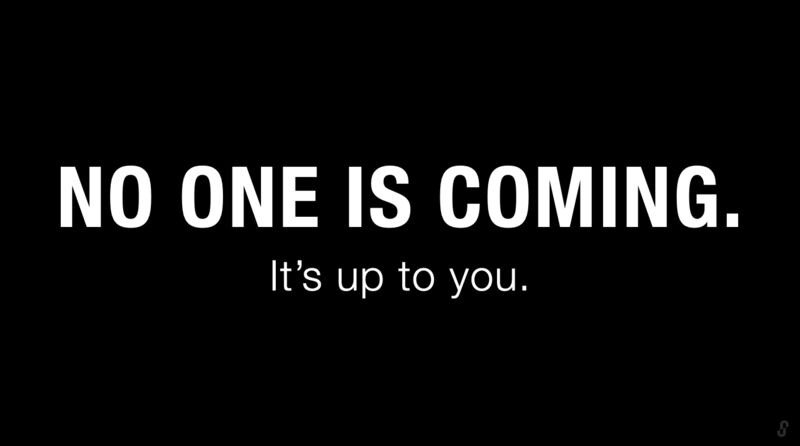Earlier this week storytelling maestro Ron Tite posted this image to his LinkedIn profile. It would be fair to say “it went viral”
In the important backstory this image was a sticker prominently displayed on the cover of a CMO’s laptop. And as the CMO recounted, whenever his team was stuck or had trepidations in the midst of a project, he would tell them to keep going, plunge forward, take the initiative and take the hill. And, to not wait or expectantly look around because…no-one was coming.
Brilliant. Bold. Heartfelt and stirring stuff.
And LinkedIn ate it up.
As must his team.
And I’ve no doubt his teams kick-ass regularly. Take the hill more often than their peers. And have the category share and volume growth results to prove it.
Earlier in my career I remember another story I was told.
There was a small, passionate team of entrepreneurs who had envisioned a great new product. They already had an MVP of sorts and were convinced their product was going to be incredibly popular. So, they doubled down inside their skunk-work feverishly working to try scale their initiative. Their competition cottoned on to what they were doing and flooded the market with superior resources. For a variety of reasons, Head Office didn’t step in and left this particular team to fend for themselves – literally no-one came – and this plucky team of entrepreneurs were over run. Actually, their market competition ran straight over them.
That’s the story of The Alamo.
We all know that stories are one of the most powerful weapons in the arsenal of any culture.
For customer service organizations these stories – these myths – become powerful bonding agents that can inspire and motivate employee behaviour years after they happened. Look no further than the Nordstrom’s tyre return story to see just how powerful and long-lasting one satisfied customer story can set a bar for decades.
What we seldom, if ever, discuss are the equally powerful stories and myths that stifle our people and impede the success of our organizations.
The stories of employees who asked a question at an All-Staff and then were summarily fired 2 weeks later. The stories of executives coming back from a off-site at a 5 Star Resort then initiating a massive series of cost-cutting measures because the company needed to watch its cash-flow. The stories of young female colleagues being invited to dinner with senior male clients just to help “accelerate closing the deal”
Those are the dark and dire stories that are equally embedded in the DNA of your organization too.
In fact, I’d put money on it, those stories are even more virulent, have more traction and travel with more speed through the informal network of your organization than any story about your proud founder who once chopped down their father’s favourite cherry tree3.
The sad reality for many beleaguered Executives is those stories are not the ones that reach their ears. Many of the stories of how things really work around here seldom reach beyond the shop floor or the water-cooler chat that Managers and Executives are invited or privy to.
The even more dangerous reality is that some of those stories are actually myths.
Myths that really should have no credibility because they never actually happened.
But your employees and your Culture believe that they did!
The fired employee wasn’t fired for their All-Staff question, but they left for a better paying job closer to home. The Executives actually went to a 3-Star Resort owned by one of the Board Members and they got a further discount.
Sadly, the young female employees being coerced into attending a client sales dinner is a reality that still occurs far too often in far too many aggressive sales cultures. My hope is that when those stories surface the senior Executives responsible do get fired.
If you really want to nurture a culture to do great heroic and monumental things, then you need to deeply understand the motivations and myths of your culture4.
What are their soaring stories of inspiration, recognition, and motivation? What are their cautionary tales of fear, trepidation and corporate retribution? What stories and myths are you not hearing around the virtual water cooler and post-Zoom debates?
If I can impart three words to any Executive reading this, three words that may help them create a truly impressive and successful culture.
Resources
1. The Wikipedia version of the Battle at the Alamo
2. A Washington Post article that highlights that The Alamo might not be as heroic as traditionally portrayed.
3. The George Washington Cherry Tree Myth
4. The excellent folks at SLAP are masterful at getting a culture to reveal these stories and powerful myths.


